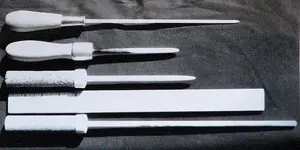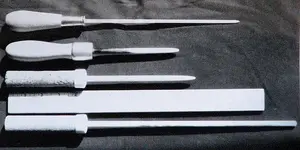Silver Fox
Sr. Member
- Joined
- Dec 8, 2007
- Messages
- 485
- Reaction score
- 5
- Golden Thread
- 0
- Location
- New York City, USA
- Detector(s) used
- Bounty Hunter Land Star
- #1
Thread Owner
I post this helpful hint in General Discussion for its wide audience and because I looked for and didn't find a How-To forum although it might still be moved by a Mod.
I mentioned in another Forum about how I stopped damaging coins using a homemade fiberglass probe which also allows me either not make a hole or if I have make a hole it will be about the same size as the target when it's a coin, medal, etc., and it triggered this request: "Can I get some details on that technique? What kind of pinpointer do you use, must be sturdy? I'd sure like to be able to retrieve targets as shallow as 2" without digging. Thanks in advance for the tips." I answered him with the following but thought you all might also be interested. No digs (pun) at anyone here were intended.
Look at the photo which is worth a thousand words, fiberglass fishing pole probes in various states from new to used. Get a solid fiberglass fishing pole and remove all of the hardware. Get some rasp-type thick wood handles. Add white glue.
Cut the fishing pole into sections approx. 12" in length. If the thinnest part is too flexible discard it. You want a section that cannot be bent. Thin the thickest (or upper) part of the section so that it will eventually fit into the handle's hole all the way or most of the way (you don't want it detaching in the field). Fill the handle hole almost all of the way with the white glue. When you insert the section into the hole glue will squish out, just wipe the excess (don't hold the handle upside down so that the glue leaks out before you insert the section). Stand it on the handle somewhere out of the way to let the glue dry. Takes about a day or two. When the section is solidly in the handle and your efforts to pull it out fail, you're ready for the next step. That's rounding the flat tip so that it becomes easy to insert the probe into the earth.
That's it, and now you don't have to worry about damaging mostly coins when you probe to touch whatever triggered your detector. If it's a ring your probe might go through the center so a probe is effective with solid targets such as coins, medals, etc. Once your probe has touched the object find its edges and then you don't have to make a big hole to retrieve it. And doing so gives you more hunting time. Very few use a probe and since they don't know how big it is they wind up making a crater to retrieve a clad cent! Using a probe is ecological!
Using a probe is ecological! 
Silver Fox
I mentioned in another Forum about how I stopped damaging coins using a homemade fiberglass probe which also allows me either not make a hole or if I have make a hole it will be about the same size as the target when it's a coin, medal, etc., and it triggered this request: "Can I get some details on that technique? What kind of pinpointer do you use, must be sturdy? I'd sure like to be able to retrieve targets as shallow as 2" without digging. Thanks in advance for the tips." I answered him with the following but thought you all might also be interested. No digs (pun) at anyone here were intended.
Look at the photo which is worth a thousand words, fiberglass fishing pole probes in various states from new to used. Get a solid fiberglass fishing pole and remove all of the hardware. Get some rasp-type thick wood handles. Add white glue.
Cut the fishing pole into sections approx. 12" in length. If the thinnest part is too flexible discard it. You want a section that cannot be bent. Thin the thickest (or upper) part of the section so that it will eventually fit into the handle's hole all the way or most of the way (you don't want it detaching in the field). Fill the handle hole almost all of the way with the white glue. When you insert the section into the hole glue will squish out, just wipe the excess (don't hold the handle upside down so that the glue leaks out before you insert the section). Stand it on the handle somewhere out of the way to let the glue dry. Takes about a day or two. When the section is solidly in the handle and your efforts to pull it out fail, you're ready for the next step. That's rounding the flat tip so that it becomes easy to insert the probe into the earth.
That's it, and now you don't have to worry about damaging mostly coins when you probe to touch whatever triggered your detector. If it's a ring your probe might go through the center so a probe is effective with solid targets such as coins, medals, etc. Once your probe has touched the object find its edges and then you don't have to make a big hole to retrieve it. And doing so gives you more hunting time. Very few use a probe and since they don't know how big it is they wind up making a crater to retrieve a clad cent!
 Using a probe is ecological!
Using a probe is ecological! 
Silver Fox



